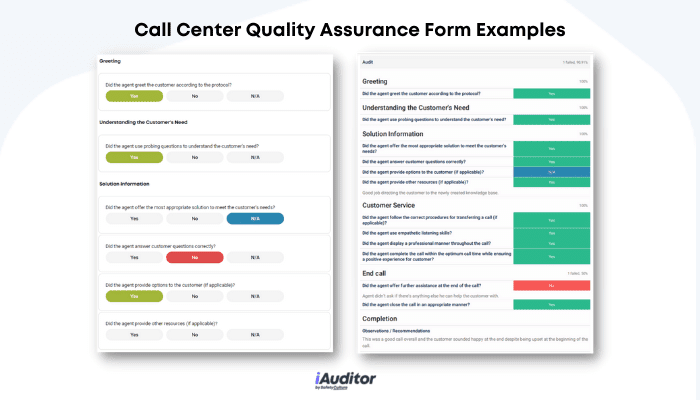What is Call Center QA?
Call Center Quality Assurance (QA) is a process that can help ensure customer interactions are aligned with business goals. Call center QA aims to identify common customer issues, improve customer experience, and help standardize communication processes with customers.
Why is QA Important in a Call Center?
Quality assurance in call centers is important because it can enhance agent performance and maximize customer satisfaction. When end-user interactions are of the highest quality (e.g. quick response and handling time), volume decreases and key performance indicators such as Net Promoter Score (NPS) and Customer Satisfaction (CSAT) increases.
How is Call Quality Assessed?
Call quality is typically monitored by the team leader, quality assurance specialist member, or call center quality analyst. There are commonly two categories of data, also known as quality parameters, that are assessed when monitoring QA in call centers:
- Call and customer metrics: these include average response time, handling time, customer satisfaction ratings, NPS ratings, CSAT scores, productivity metrics, etc.
- QA assessment: performed by a team leader or QA specialist on a sample of customer interactions assessing the resolution and professionalism against an agreed scorecard
QA is a critical tool to measure improvement over time and maintain a high level of customer satisfaction.
What Makes a Good Call Center Quality Analyst?
Being an effective quality analyst for call centers is crucial because the reputation of the business process outsourcing (BPO) company relies heavily on the quality of service they seek to continuously improve. Listed below are some skills required for call center quality analysts:
- Excellent problem-solving and issue resolution
- Solid analytical skills and technical comprehension
- Outstanding written and verbal communication
- Exceptional interpersonal skills and customer care
- Keen attention to detail and thoroughness
Tips for Call Center Quality Assurance
Call center quality assurance can seem challenging because of the sheer volume of calls to be assessed, but it is necessary to identify areas of improvement, especially for call center customer service agents. Here are some tips to help you create a call center QA process, effectively fulfill QA tasks, and improve call center quality:
#1 Set your priorities
Are you aiming to get the highest CSAT among peers? Do you need to make sure that the 800 calls on a queue are answered with minimum abandoned calls? Are you customer service-focused or more about technical support? Is your Net Promoter Score (NPS) or CSAT falling behind that of competitors? What are your Key Performance Indicators? Where do you stand according to your benchmarking? You need to know what to prioritize and build your QA forms according to your focus.
#2 QA should be ongoing
QA is an ongoing process for a call center and you should make sure that representatives are aware it is indeed ongoing. Recordings should be done often enough for calls, emails, or chats because these communications can be used to determine the quality of customer interactions. The quality of these communications can then be discussed during coaching and training sessions. QA monitoring done consistently can reinforce good habits that help improve customer experience and address areas for improvement.
#3 QA everyone
All employees who interact with customers should be monitored and coached for QA regardless if they are top performers, underperformers, or mid performers because there will always be areas for improvement. Those who underperform can greatly benefit from QA coaching because errors can be addressed. While for mid and top performers, reinforcements or recognition of good practices can be accomplished during coaching sessions.
#4 QA should help achieve business goals
“This call may be monitored for quality assurance and training purposes” is exactly what it says. QA can use recorded communications with customers for QA coaching and training opportunities for employees to improve their customer interactions. Recorded communications can also help in the improvement of operational processes.
#5 Don’t lose sight of the customer
Solely relying on a QA scorecard can lead to adverse outcomes for customer interaction. A QA scorecard should only be used to assist with achieving a minimum standard of call. All team members should be encouraged to go above and beyond in delivering a positive customer experience even if that directly contradicts a scorecard. Remember, customers and agents are humans and not all interactions can be graded in a scorecard.
Scale Your Enterprise Operations with Customizable Solutions
✓ Scale ✓ Data ✓ Security ✓ Integration ✓ Teams
Learn MoreHow to Improve Quality Assurance in Call Centers
Below are additional ways to help improve quality assurance in call centers:
- Streamline the monitoring process – Standardized the QA process by creating a comprehensive and systematic approach that enables leaders to gather enough information to improve call handling and call quality. This way, it’s easier to monitor, track, and justify the QA process for its effectiveness.
- Determine the best monitoring setup – Each organization has specific processes that work for them so don’t just stick to generic monitoring approaches. Aside from random sample calls, and qualitative and quantitative data, self-analysis scorecards can also be considered to further strengthen the way calls are assessed. All these can be combined and experimented on until the authorized personnel identifies the most effective approach for the business.
- Recognize coaching opportunities – It’s important to reiterate best practices and provide training to agents from time to time. This can be a good determining factor in realizing which areas in processes need improvement, which of them work and should be implemented widely, and which of them are not working and therefore should be halted altogether.
- Create an encouraging culture – Although the primary goal of QA is to deliver feedback and identify learning opportunities, don’t forget to also recognize favorable assessments and reward employees for their participation. This creates an encouraging culture with employees which in turn, contributes to the improvement of the whole process of quality assurance.
- Use suitable tools – Observe continuous improvement by utilizing tools that ease the QA process of call monitoring. It’s ideal to have real-time information to be able to identify recurring issues and address them promptly.
Why Standardize Call Monitoring?
An ever-changing call monitoring process makes it more difficult for team leaders to develop high-performing call center agents. Miscommunicating updated quality standards also add to the burden of keeping the growth of team members in mind. Call center managers and quality assurance analysts should standardize how they perform call monitoring to easily determine and follow through on exactly how a call representative should improve.
Achieve operational excellence
Cultivate a culture of excellence with our digital solutions that enhance efficiency, agility, and continuous improvement across all operations.
Explore nowTools for Call Center QA
QA forms that are standardized, carefully constructed, and easy to use are great tools for QA monitoring. Scoring and Analytics available in SafetyCulture (iAuditor) can help QA specialists gauge the quality of calls, monitor trends, provide Training opportunities, and identify frequently failed items.
SafetyCulture group administrators can control the permissions of other SafetyCulture users to make sure that QA forms used are standardized across the board. With data collected and secured in cloud-based storage, SafetyCulture can help QA specialists determine the proper action plans and align communication processes with business goals.
Call center QA exists to help businesses improve their interaction with customers, benchmark communication processes, and drive employees to work together towards achieving business goals. With the help of tools like SafetyCulture, you can determine what you need to improve on to consistently deliver your ideal customer experience.
Create a Quality Assurance Checklist for Call Centers
Eliminate manual tasks and streamline your operations.
Get started for FREE



